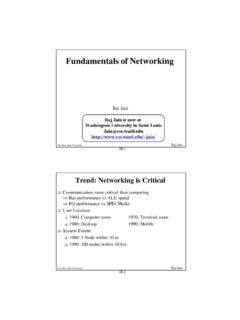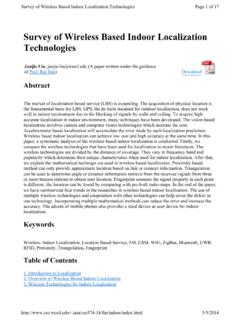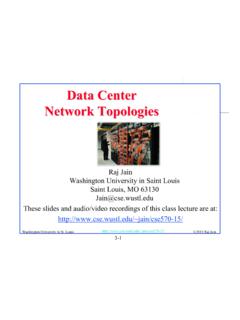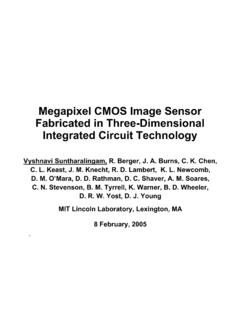Transcription of Abstract: Table of Contents - cse.wustl.edu
1 Ti mothy York, (A paper written under the guidance of Prof. Raj Jain)DownloadAbstract: image sensors are everywhere. They are present in single shot digital cameras, digital video cameras, embedded in cellular phones, and many more places. Whenmany people purchase a digital imager, the primary metric they use as a comparison is the pixel array size, expressed in megapixels. The higher the megapixelcount, the better the imager is the prevailing wisdom to most consumers. There are many more metrics with which to compare imagers that may give a betterindication of performance than raw pixel counts. Further, many of these metrics may be based on the type of imaging technology, CCD (charge coupled device)or cmos ( complementary metal oxide semiconductor). This paper will explain the fundamentals of how a digital image sensor works, focusing on how photonsare converted into electrical signals, and thus images. It will detail the difference between the functionality of CCD and cmos sensors, the two chiefarchitectures for image sensor design.
2 It will also discuss various metrics which are commonly used in analyzing the performance of image sensors. It will includea statistical comparison of recent CCD and cmos imaging systems from the literature using these metrics, and compare them to some commercially availablesensors. It will also develop a model for how two of these metrics, well capacity and conversion gain, are : image sensor , cmos image sensor , CCD, performance analysis, well capacity, conversion gain, image sensor metricsTable of Contents :1. The Physics of Silicon image Measuring Light CCD image cmos image Sensors2. Performance Metrics for image Metrics Related to Pixel Metrics Related to Pixel Metrics Related to Pixel Readout3. A Performance Comparison of Selected image Comparing CCD vs cmos A Model of Conversion Gain and Well Discussion of Results4. SummaryReferencesList of Acronyms1. IntroductionImage sensors are being used in many areas today, in cell phone cameras, digital video recorders, still cameras, and many more devices.
3 The issue is how toevaluate each sensor , to see if significant differences exist among the designs. Megapixels seem to be the largest used barometer of sensor performance, with theidea that the more pixels an imager has, the better its output. This may not always be the case. Many other metrics are important for sensor design, and may givea better indication of performance than raw pixel count. Furthermore, specific applications may require the optimization of one aspect of the sensor 'sperformance. As silicon process technology improves, some of these metrics may get better, while others might become paper will explain how light is converted into a digital signal. In Section 1, it will give a background on how silicon photosensors operate. Section 2 will usethat background to illustrate a number of commonly used metrics for image sensor performance. Section 3 will do a comparative analysis of CCD and cmos sensors using some of these metrics, based on sensors published in the literature.
4 A model will also be discussed which shows how two of them are 4 will summarize the The Physics of Silicon image SensorsThe first thing to explain is how a modern digital image sensor works. Nearly every modern image sensor today is produced using silicon. The chief reason is thatsilicon, being a semiconductor, has an energy gap in between its valence band and conduction band, referred to as the bandgap, that is perfect for capturing lightin the visible and near infrared spectrum. The bandgap of silicon is eV. If a photon hits silicon, and that photon has an energy more than eV, then thatphoton will be absorbed in the silicon and produce charge, subject to the quantum efficiency of silicon at that wavelength. The energy of a photon is defined as[Nakamura2005] Plank's constant, h, times the the speed of light c, divided by the wavelength of the light, . Visible light has wavelengths between about 450 nmto 650 nm, which corresponds to photon energies of eV and eV respectively.
5 These wavelengths are absorbed exponentially from the surface based ontheir energy, so blue light (450 nm) is mostly absorbed at the surface, while red light penetrates deeper into the of image sensor ~jain/cse567-11/ftp/ of 85/4/2011 4:49 PMFigure 1 - Illustration of Photon to Charge ConversionMost silicon photodetectors are based on a diode structure like the one shown in Figure 1. The crystalline structure of pure silicon is doped with different types ofmaterials to produce silicon that uses holes (positive charges, and hence p-type) or electrons (negative charges, or n-type) as the majority carriers. When thesetwo types of silicon are abutted, they create a diode, which only allows current flow in one direction. Furthermore, a region depleted of charge, called thedepletion region, is formed at their junction. This is shown in the figure as the area in between x1 and x2. The width of this depletion region is a function of therelative dopings of the p and n silicon, as well as any reverse bias voltage placed between the n and p a photon hits the silicon, it penetrates based on the wavelength, and, if it is absorbed, will create an electron-hole pair where it absorbs.
6 There are thusthree places where this electron-hole pair can be formed, either in the p-type bulk, the n-type bulk, or the depletion region. If it is formed in the depletion region,then the electron-hole pair are swept away, thus creating a drift current, since current is created when charges move. If it is absorbed in the n-type region, theelectron will remain, as the majority carriers in n-type are electrons, and thus the hole that is formed is left to diffuse toward the depletion region. This situation isreversed in the p-type silicon, where the electron diffuses. These diffusions also create a current. Thus, the total current in the photodiode is the addition of thesetwo diffusion currents and the drift current, with the amount of current based on how many photons are hitting the sensor , as well as the sensor 's area. A largersensor can collect more photons, and can be more sensitive to lower light Measuring the Light IntensityTo measure how much light hits the sensor , the current could be directly measured.
7 The currents produced by the photoconversion are typically very small,however, on the order of femtoamperes (1e-15 A), which discourages an accurate direct measurement. Thus, nearly all sensors employ a technique calledintegration, where the voltage across the photodiode is set to a known potential, and the photodiode is then left to collect photons for a known period of timebefore the voltage is read out. Longer integration allows more charges to be converted, and thus measurable changes in the voltage can be 1 - Output Voltage After IntegrationEquation 1 shows how direct integration works. Vout is the output voltage measured across the photodiode, iphoto is the photocurrent, which is assumed to beconstant during the integration time, tint is the integration time, and CD is the capacitance of the photodiode. Since the capacitance of the photodiode is usually inthe femtofarad range, this offsets the small photocurrent values, which are typically on the same scale, and so the change in voltage is magnified by theintegration time into something that can be directly measured.
8 Using a first order approximation, the capacitance and integration time are assumed constant, sothe output voltage changes linearly with the amount of photocurrent, which is a direct measure of the number of photons hitting the CCD image SensorsAn alternate way to look at direct integration is to think about the capacitance that is present from the formation of the depletion region. When the photodiode isreset, the maximum amount of charge is placed on this capacitance. As photons are converted into charges, these charges are removed from the capacitorcreating the photocurrent. At the end of integration, the number of charges left in the capacitor would be directly proportional to the number of photons that hitthe sensor . If the number of charges could be measured, then the amount of light that hit the sensor could be as sensors work by transferring the charge from one pixel to another until they end up at the periphery, and are then converted into a voltage to be read charge transfer is accomplished by applying voltages that form wells of different potentials, so the charges transfer completely from one pixel to the typically are shifted downward to the end of a column, then rightward to the end of a row, where the readout circuitry is present.
9 The charge to voltageconversion then takes place, since voltage output is proportional to the charge over the capacitance, as seen in Equation 2 Fundamentals of image sensor ~jain/cse567-11/ftp/ of 85/4/2011 4:49 PMEquation 2 - Charge ConversionThere are two main types of CCD architectures, frame transfer and interline transfer. In frame transfer, the charges from the pixels are moved from thephotosensitive pixels to a non-photosensitive array of storage elements. They are then shifted from the storage elements to the periphery where they areconverted and read out. In interline CCDs the non-photosensitive storage element is directly next to the photodiode in the pixel. The charges are then shiftedfrom storage element to storage element until they reach then readout cmos image SensorsCCDs are designed to move charges from pixel to pixel until they reach amplifiers that are present in the dedicated readout area. cmos image sensors integratesome amplifiers directly into the pixel.
10 This allows for a parallel readout architecture, where each pixel can be addressed individually, or read out in parallel as agroup. There are two main types of cmos image sensor modes, current mode and voltage mode. Voltage mode sensors use a readout transistor present in thepixel that acts as a source follower. The photovoltage is present at the gate of the readout transistor, and the voltage read out is a linear function of the integratedphotovoltage, to a first order approximation. Current mode image sensors use a linear relationship between the gate voltage of the readout transistor and theoutput current through the transistor to measure the 2 - Three Transistor Voltage Mode cmos SensorFigure 2 shows a typical three transistor voltage mode cmos pixel [Nakamura2005]. The reset transistor allows the the photodiode to be reset to the knownpotential, the switch transistor allows the photo voltage to be placed on the readout bus, and the readout transistor converts the photo voltage to an outputvoltage that gets placed on the readout bus.



















